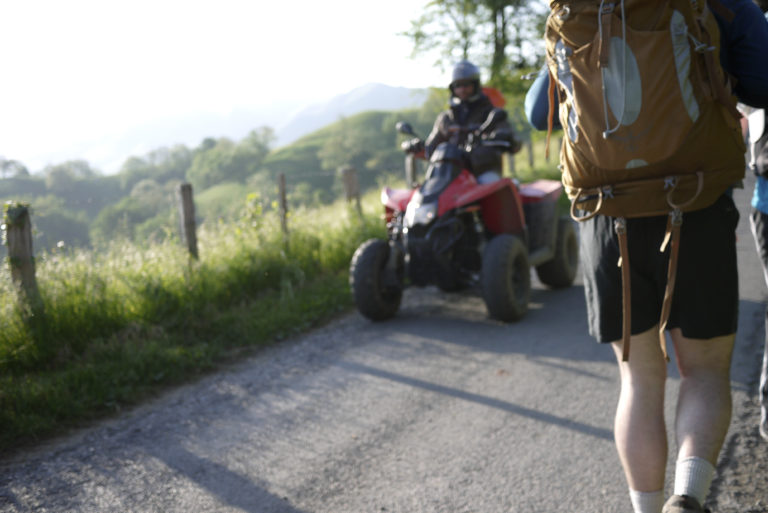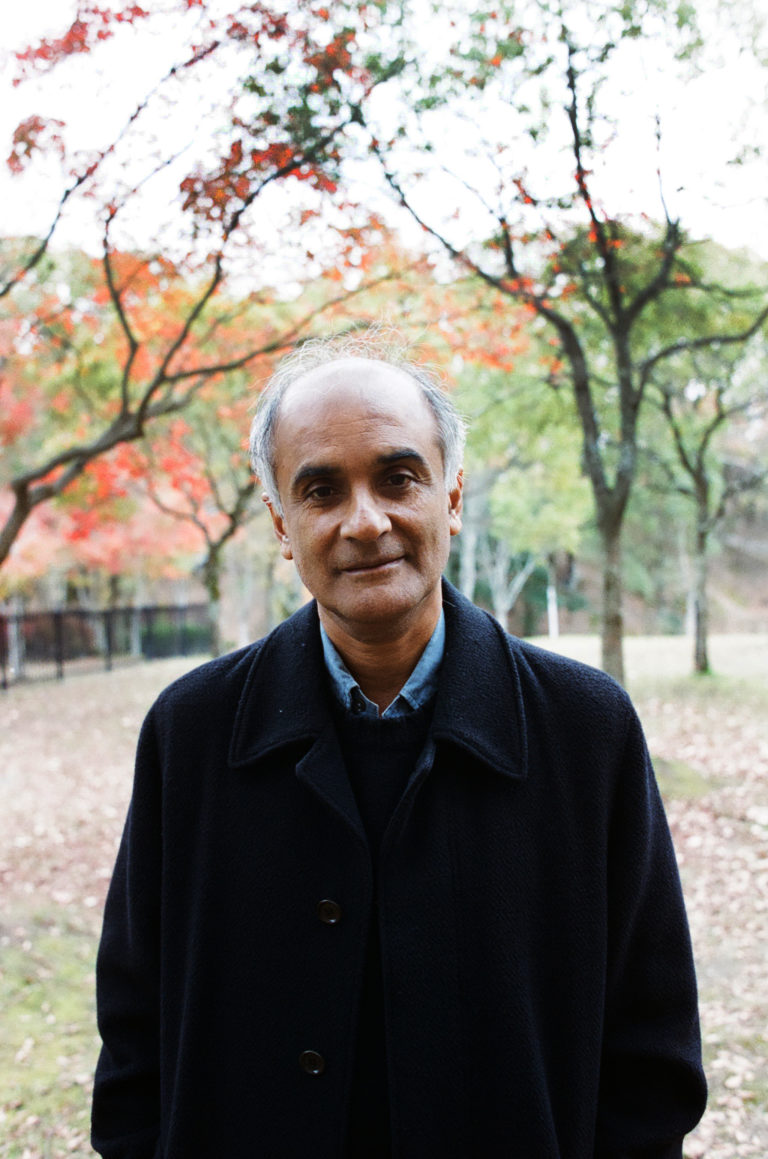
Image by Sarah Hackney/Flickr, Some Rights Reserved.
Walking the Camino in the Age of Wi-Fi
It was the dawn of Facebook and smartphone use in 2007 when I first walked the 500-mile long Camino de Santiago — the thousand-year-old pilgrimage route across northern Spain. In modern times, the Camino has exploded in popularity. Pilgrimage along its path has become fundamentally an experience of reflection and self-discovery, though some still make the trek for religious reasons.
Behavior that is acceptable in public today — such as posing for selfies, constantly checking email, posting and texting in meetings and in class and in almost any social situation with friends and family — would have seemed odd, perhaps even rude back then. But things have changed.
When I got home in 2007, I began planning a way to go back and bring some of my students from Franklin Pierce University, where I teach sociology. In 2011 and 2013, I led the first two such trips with my wife, who co-leads the study abroad program. We decided to ban mobile phones and MP3 players. We wanted the students to not be “plugged in” and “checked out” while on their pilgrimage. We didn’t want them to be distracted by the technology from their own experience of solitude and the sounds around them, or to miss out on the opportunities to converse at length with others they would be walking with and meeting along the way.
We also knew that a full semester abroad was a gift of time — a rare opportunity to live in an unfamiliar place, to “wake up,” and to live more mindfully through daily walking and the simple rituals of pilgrim life. We believed that if they could limit their use of the Internet and their contact with home while on the Camino, it would help them develop a more intimate relationship with themselves and with each other, and reflect on their lives.

We led our third trip last year in the fall of 2015, and, with each excursion, we have encountered increasing resistance from students to our limited-use-of-technology policy. I have also noticed more resistance to the policy within myself.
My wife and I took our own iPhones on our first two trips. We used them primarily to pay our monthly bills back home and occasionally check in with family members when we had a rest day and stayed at hotels that offered Wi-Fi, and planned to do so again. For better or worse on our last trip, we succumbed to our students’ appeals and let them bring their phones.
What we were not expecting was the rapid spreading of Wi-Fi to not only all hotels, but to virtually every albergue, bar, and café in such a short time span. Nearly every pilgrim had a smartphone, and many carried a tablet and some even a laptop in place of a journal on which to blog about their journey and upload photos to the Internet. The old computers in hostels and bars that we used to a pay a few euros to get a few minutes online were sitting unused, collecting dust in the corners like dinosaurs fading into extinction.
Widespread access to the Internet made it a struggle for us all to keep our phones tucked away. At the beginning of our trip, we had several conflicts and tense conversations over the matter, as we tried to negotiate how to limit our smartphone use.
In the pilgrim hostels at night, we could see the habits well-formed in ourselves and others. Instead of a room full of pilgrims chattering, singing, or playing cards with each other, the common areas were, in the words of MIT professor of social studies of science and technology Sherry Turkle, full of people “alone together.”
These technologies, Turkle says, are increasingly where we turn when we wish to avoid the more demanding, less controllable, messiness and sometimes boredom of real relationships. The new technology gives us more control over where we put our attention. What we get in return is the feeling of being heard, that we matter, that we are not alone.

But, Turkle warns, momentary connections online are not the same as what happens in real relationships, and can actually leave us more isolated and less satisfied, though cloaked in a sense of togetherness. In other words, texting and posting may be good for sharing discrete bits of information, but they don’t add up to a real conversation where we learn about, and come to understand, each other in all our richness and complexity as human beings.
Likewise, she argues, the more we habitually turn to our phones and other devices for virtual connections, the more we are losing the capacity for solitude — time spent alone in conversation with one’s self. Without solitude, we can’t really know ourselves — the prerequisite for forming genuine attachments to others. Isolation, anxiety, and depression, she cautions, are dangers of an unexamined and addictive use of technology. Turkle’s studies raise the question, “As we expect more from technology, do we expect less from each other?” My observations along the Camino lead me to answer “yes.”
More often than not, the time preceding or following dinner in an albergue was not as social as in years past before the Wi-Fi revolution. Instead, they were scenes of people together, but alone, sitting side by side buried in the screens of their phones, fingers texting, posting photos on Facebook, and occasionally talking with someone back home while interacting very little with other pilgrims in the same room.
Increasingly, the first question pilgrims ask these days upon arriving at an albergue, according to many hostel owners and volunteers (hospitaleros), is “Do you have Wi-Fi?” At the church-based, Dutch refuge in Villamayor de Monjardin, which has intentionally decided to not offer Wi-Fi as an amenity, a hospitalero told me sadly that many pilgrims leave once they hear that fact, sometimes adding many more kilometers to an already lengthy day of walking to find one that does.

The beauty of the Camino for me has been that you could put technology aside and leave the world back home. In its place, you immerse yourself in solitude, the kindness of strangers, fellowship, and conversation with your fellow travelers. To the degree that we allow ourselves to be transformed into device people hopelessly hooked on our smartphones and continuously occupied e-mailing, texting, Facebook liking, Skyping, watching YouTube videos, and playing Candy Crush, that kind of retreat will be in jeopardy.
While we saw pilgrims all around us in 2015 going at their electronic devices with seeming abandon and we lamented the losses brought about by such distraction, my wife and I felt some hard-won consolation by mid-trip. After weeks of battling and reasoning with our students combined with time on the trail, most of them came to see some wisdom in limiting their cell phone use while on the Camino. They were even a bit relieved to take a vacation from their online lives and were happier for it.
Given the fact that cell phone and social media use will remain a reality along the Camino from now on, our observations have taught us that we need to develop a more intentional set of rules to limit our use of this technology on future trips.
As Sherry Turkle observes, this technology, and our use of it, is still relatively new. We are in the early stages of understanding not only what it can do, but also what it does to us. Hopefully, we will be able to step back and reconsider how we use our cell phones and where that technology is taking us. Most importantly, we must not allow it to steal our capacity for solitude and conversation, those twin paths to self-discovery and communion, which have animated the modern motivation for walking the road to Santiago and why so many people cherish their time on it.


Share your reflection